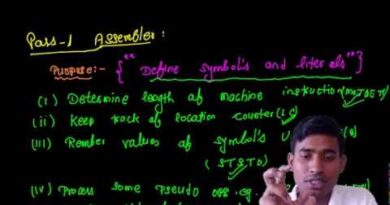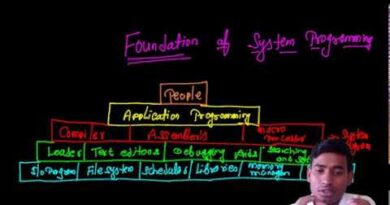System Programming: Pass 1 assemblers-Concept of single pass Assemblers and it’s working in system programming
System Programming: Pass 1 assemblers-Concept of single pass Assemblers and it’s working in system programming.
Contents [hide]
- 0.1 Pass 1 Assemblers in System Programming
- 0.2 What is a Single Pass Assembler?
- 0.3 Working of a Single-Pass Assembler
- 0.4 Key Functions in Pass 1:
- 0.5 Advantages of Single-Pass Assemblers
- 0.6 Disadvantages
- 0.7 Example: Single-Pass Assembler in Action
- 0.8 Conclusion
- 0.9 System Programming: Pass 1 assemblers-Concept of single pass Assemblers and it’s working in system programming
- 0.10 Module 1: Assemblers – WBUTHELP.COM
- 0.11 System Programming
- 1
System Programming – Single Pass Assembler (Pass 1 Assembler)
- 2
What is a Pass in Assembler?
- 3
Single Pass Assembler – Concept
- 4
Key Characteristics of Single Pass Assembler
- 5
Diagram: Single Pass Assembler Working
- 6
Forward Reference Example
- 7
Use Cases
- 8
Summary Table
Pass 1 Assemblers in System Programming
Assemblers are programs that convert assembly language code into machine code. Based on how they process the source code, assemblers are categorized into Single-Pass and Multi-Pass assemblers.
What is a Single Pass Assembler?
A Single-Pass Assembler processes the source code in one pass, meaning it scans the assembly code only once to generate machine code. It does not revisit instructions, making it fast but limited in handling forward references.
Example of Forward Reference:
A single-pass assembler struggles with this because it encounters JMP LABEL before knowing its address.
Working of a Single-Pass Assembler
Key Functions in Pass 1:
-
Scanning the Source Code
- Reads each line of assembly code.
-
Generating the Symbol Table
- Records labels and their memory locations.
- Handles forward references (may use a fix-up approach).
-
Assigning Addresses (Location Counter – LC)
- Tracks instruction memory addresses.
- Increments
LCfor each instruction.
-
Translating to Machine Code
- Converts mnemonics into opcodes.
- Tries to resolve addresses immediately (if possible).
-
Handling Forward References
- If an address is unknown, it may generate incomplete machine code and fix it later.
Advantages of Single-Pass Assemblers
Faster execution since only one pass is needed.
Requires less memory compared to multi-pass assemblers.
Efficient for simple assembly programs.
Disadvantages
Cannot fully handle forward references efficiently.
May produce incomplete machine code, needing extra fixes.
Limited error checking compared to multi-pass assemblers.
Example: Single-Pass Assembler in Action
Consider the following assembly code:
| Instruction | Address | Action |
|---|---|---|
| MOV A, B | 1000 | Encoded directly |
| JMP LABEL | 1001 | Address unknown (forward reference) |
| ADD C | 1002 | Encoded directly |
| LABEL: SUB D | 1003 | Define LABEL (resolve previous JMP) |
| HLT | 1004 | Encoded directly |
- Pass 1 assigns addresses and stores labels in a symbol table.
- Forward references (e.g., JMP LABEL) require fixes later.
Conclusion
A Single-Pass Assembler is fast and memory-efficient, making it suitable for simple systems. However, forward references pose a challenge, which Multi-Pass Assemblers solve by scanning the code multiple times.
Would you like a detailed example with machine code generation or comparison with a Two-Pass Assembler?

 What is an Assembler?
What is an Assembler? Want more?
Want more? Efficiency
Efficiency No Re-scanning
No Re-scanning Symbol table
Symbol table Forward reference issue
Forward reference issue GATE-level MCQs on Single vs Two Pass Assemblers
GATE-level MCQs on Single vs Two Pass Assemblers A simulated example with real assembly input and machine code output
A simulated example with real assembly input and machine code output
